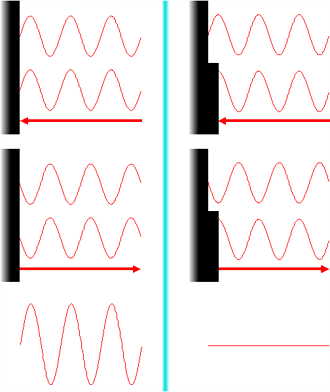2. Laser
Laser light is coherent
How do we explain the sporadic appearance, also known as speckle pattern, of the laser light as shown on the previous page? The illustration on the right column may help.
We just learned that a laser produces light that is monochromatic, in other words, light that exhibits only one wavelength. When all elementary waves in a monochromatic light beam move with an identical phasing, we then speak of coherent light. The screen used here has a rough surface. When coherent light falls on this surface, the speckle pattern comes about as follows:
-
On the left:
Light waves fall on a smooth even surface (top). The light is reflected (middle). At the point of observation, the reflected wave trains interfere constructively with one another (bottom). The observer perceives a bright spot. -
On the right:
Light falls on a rough uneven surfave (top). It is now reflected by two different surface levels (middle). If these two levels lie 1/4 of a wavelength apart, the path of the light that is reflected by the rear level is then 1/2 of a wavelength longer than the path of the light that is reflected by the front level. At the point of observation, the reflected wave trains interfere destructively with one another (bottom). The observer perceives a dark spot.

Explanation of the speckle pattern.
Laser light is monochromatic and most - but not all - lasers emit coherent light. It is coherence which makes laser light distinct from all other light sources.
